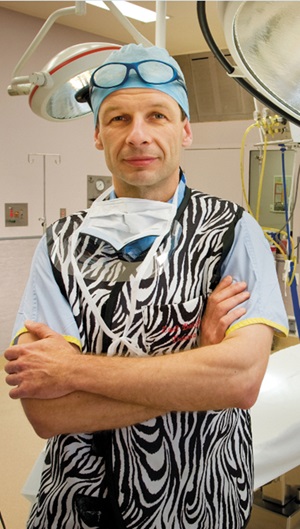2024 | Volume 25 | Issue 2
Hospitals are improving their trauma care for patients—from transport to hospital to rehabilitation and beyond—with the help of the RACS Trauma Care Verification Program.
In a recent project, the trauma processes of six hospitals in central Aotearoa New Zealand were assessed in February 2024.
In addition to evaluating the individual hospitals, the trauma system, including coordination of injured patients between hospitals and overall governance, was examined.
This project continues Aotearoa New Zealand’s strong history of trauma quality improvement, it was the first country to undertake Trauma Care Verification of the trauma system across the entire system in 2017.
The Trauma Care Verification Program takes place in various stages, with hospitals completing a detailed review questionnaire, followed by a hospital visit, which includes medical record review by a team of medical specialists, nurses and allied health practitioners.
A detailed report with recommendations and advice on areas of improvement is provided following the site visits.
The Trauma Care Verification Program is part of RACS commitment to upholding the highest standards of trauma care in Australia and Aotearoa New Zealand.

John Hunter Hospital Trauma Director and researcher, Professor Zsolt Balogh, led the team reviewing Wellington and Hutt Hospitals and was the overall lead for the trauma system review. He said the process aimed to ensure hospitals and medical staff had the resources and processes in place to help them deliver optimum care to trauma patients.
“The Trauma Care Verification Program is a peer review process overseen by RACS in collaboration with other specialist bodies like the colleges of emergency medicine, intensive care medicine and anesthetists, with nursing and allied health involvement.
“The team reviews hospitals using evidence-based criteria referenced to national and international standards. This process aims to secure optimal resources and ensure processes are in place to manage major trauma patients.”
All stages of a patient’s journey are evaluated, from their arrival at a hospital to their rehabilitation; disaster planning, patient wards and blood bank, and laboratory procedures are also all assessed.
The program is run on a voluntary basis, with hospitals, health services or governments signing up to participate.
A comprehensive review of the New South Wales Trauma Centres is currently being undertaken, with a review of South Australian Trauma System recently completed.
Professor Balogh, the chairperson of the ANZ Trauma Care Verification Program, said the program’s recommendations could lead to a change in funding of the health service or hospital.
“If the team of reviewers considers a hospital doesn't have enough resources for case managers, nurses, trauma surgeons, or in any other area of human or infrastructure, we make this clear in the report.”
A problem that often comes to light through the program is a lack of staffing for trauma management.
“There are unique features and idiosyncrasies in individual trauma centres and trauma systems in how they provide trauma care, but trauma services are uniformly understaffed, which is true for medical, nursing staff and allied health.”
In a paper titled Trauma verification: for the trauma centre or for the trauma system? Professor Balogh wrote about the importance of the scope of the peer review program continuing to extend beyond hospitals to reviewing trauma systems to influence wider reaching change in health policy.
The ultimate aims of the Trauma Care Verification Program are to:
- decrease mortality and morbidity rates
- maximise injury prevention opportunities
- optimise long term patient outcomes
- define specific trauma education, research and training needs
- promote greater focus on trauma care within hospitals, health services and the community
- assess opportunities for cost savings with increased efficiency.

Aotearoa New Zealand National Trauma Clinical Network co-leader Dr James Moore is looking forward to the completion of the report resulting from participation in the program.
The Wellington Hospital Specialist Cardiac Anaesthetist and Intensive Care physician said he had instigated the process to ensure optimal trauma care for patients in central Aotearoa New Zealand.
“We felt it was potentially a very useful opportunity to benchmark our services against the binational standards and get an external view about what our strengths were, and any gaps in our services, to drive improvement going forward,” Dr Moore said.
The preparation for the hospital visits took about 12 months, where services were reviewed internally.
“I think that was really useful because it in some ways acted as a template of the kind of analysis where people could look at what we are doing currently and what the standards say we should have been doing.
“It allowed the opportunity for people to put things into place, to meet the standard, and to identify any areas where they weren’t going to meet a standard and flag those for discussion.”
The central region verification included hospitals ranging from small rural hospitals to a large tertiary hospital.
“It was quite a lot of work, especially for the smaller hospitals, but I think they found it to be useful in preparation for the visits.”
While there had been some anxiety surround the visits, Dr Moore was impressed by the approach to the verification, highlighting progress rather than focusing on specific case criticism.
“I think there was a lot of anxiety about the concept of having a visiting team come to your hospital and look through it and ask questions.
“But the feedback I had from all of the teams was that they found the review teams were very helpful and engaged and really positive and encouraging about the services that they were providing.
“Without fail, they found the visits to be a really positive experience.”
After the region invested heavily in the verification, Dr Moore hopes the experience will ensure improvements in trauma care.
“If we can examine ourselves against a set standard and see any gaps, we might have that need to be filled, it will be useful as a reference for negotiation with the wider health system and for government funding.”
He is grateful for the time and expertise of the Trauma Verification Program reviewers who volunteered to travel to Aotearoa New Zealand for the visits.
Dr Moore will draw on the pending report to assess the roll out of the program for all regions in Aotearoa New Zealand in his role with the National Trauma Clinical Network.
“It’s certainly something that we are interested to see—the output of—and we will look at doing more broadly across the country.”